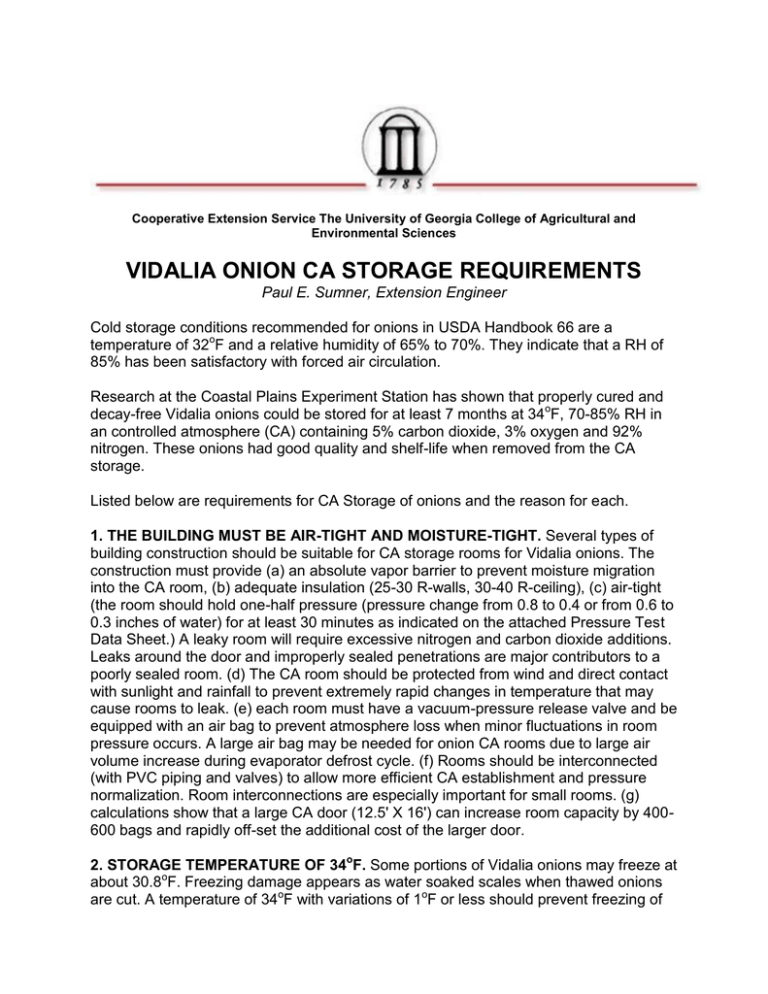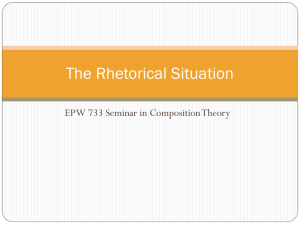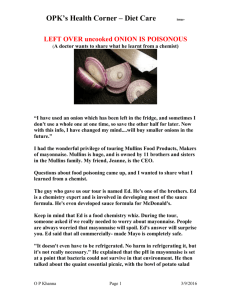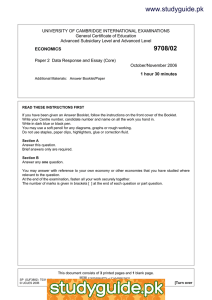Document 12330920
advertisement

Cooperative Extension Service The University of Georgia College of Agricultural and Environmental Sciences VIDALIA ONION CA STORAGE REQUIREMENTS Paul E. Sumner, Extension Engineer Cold storage conditions recommended for onions in USDA Handbook 66 are a temperature of 32oF and a relative humidity of 65% to 70%. They indicate that a RH of 85% has been satisfactory with forced air circulation. Research at the Coastal Plains Experiment Station has shown that properly cured and decay-free Vidalia onions could be stored for at least 7 months at 34oF, 70-85% RH in an controlled atmosphere (CA) containing 5% carbon dioxide, 3% oxygen and 92% nitrogen. These onions had good quality and shelf-life when removed from the CA storage. Listed below are requirements for CA Storage of onions and the reason for each. 1. THE BUILDING MUST BE AIR-TIGHT AND MOISTURE-TIGHT. Several types of building construction should be suitable for CA storage rooms for Vidalia onions. The construction must provide (a) an absolute vapor barrier to prevent moisture migration into the CA room, (b) adequate insulation (25-30 R-walls, 30-40 R-ceiling), (c) air-tight (the room should hold one-half pressure (pressure change from 0.8 to 0.4 or from 0.6 to 0.3 inches of water) for at least 30 minutes as indicated on the attached Pressure Test Data Sheet.) A leaky room will require excessive nitrogen and carbon dioxide additions. Leaks around the door and improperly sealed penetrations are major contributors to a poorly sealed room. (d) The CA room should be protected from wind and direct contact with sunlight and rainfall to prevent extremely rapid changes in temperature that may cause rooms to leak. (e) each room must have a vacuum-pressure release valve and be equipped with an air bag to prevent atmosphere loss when minor fluctuations in room pressure occurs. A large air bag may be needed for onion CA rooms due to large air volume increase during evaporator defrost cycle. (f) Rooms should be interconnected (with PVC piping and valves) to allow more efficient CA establishment and pressure normalization. Room interconnections are especially important for small rooms. (g) calculations show that a large CA door (12.5' X 16') can increase room capacity by 400600 bags and rapidly off-set the additional cost of the larger door. 2. STORAGE TEMPERATURE OF 34oF. Some portions of Vidalia onions may freeze at about 30.8oF. Freezing damage appears as water soaked scales when thawed onions are cut. A temperature of 34oF with variations of 1oF or less should prevent freezing of the onions. Each storage room should have at least 2 evaporator units with one condenser unit (sized to meet room heat gain)equipped with reheat. The defrost cycles of the evaporators should be staggered with room pvc piping interconnections among rooms to serve as atmosphere expansion/contraction buffers. A back-up cooling system may be advisable. 3. STORAGE AIR CIRCULATION SHOULD BE FORCED AT 100-200 CFM//TON OF ONIONS. Forced air circulation is needed to keep temperature and relative humidity conditions uniform throughout the CA room. Fans should be placed at the rear of the room (opposite ends from entrance door), draw air through the pallet openings of the bins into a plenum area then blow it over the cooling and dehumidification units attached through the roof of the CA room. Bin stacking should insure continuity of the pallet box fork lift openings for the entire length of the stack in line with airflow. Fan speeds should be variable controlled to attain relatively uniform RH conditions throughout the room. Fan operation should begin when the first onions are placed in a room and continue until the last onions are removed. 4. RELATIVE HUMIDITY SHOULD BE MAINTAINED AT 70%-75%. Vidalia onions will lose weight in CA storage at a rate of 1% to 1.5% per month. In a 10,000 bag storage room this represents a water generation rate of 5,000-7,500 pounds per month or 7-10 pounds per hour. The dehumidification system must be capable of removing this amount of water without significantly affecting storage temperature. Operation of dehumidification units is controlled by humidistat on units. Improper control of relative humidity, air circulation, and temperature can cause a complete loss of Vidalia onions during storage. 5. AN OXYGEN CONCENTRATION OF 3% IN THE ROOM ATMOSPHERE. A low oxygen level reduces respiration and sugar loss and prolongs storage life of onions. In this atmosphere, humans can lose consciousness in less than 30 seconds, breathing stops and your heart beat stops within minutes. DO NOT ENTER A CA ROOM THAT WILL NOT SUPPORT A FLAME (16-17% OXYGEN) WITHOUT BREATHING APPARATUS. The low oxygen level is attained by flushing the room with nitrogen gas. Nitrogen can be obtained by on site generation with a membrane or a pressure swing absorption N2 generator or through use of liquid nitrogen. All three of these sources of nitrogen gas have been used effectively for CA storage. 6. A CARBON DIOXIDE CONCENTRATION OF 5% IN THE ROOM ATMOSPHERE. A high carbon dioxide atmosphere inhibits respiration and pungency development, and prolongs storage and shelf-life after storage. Carbon dioxide production by the onions will not likely be enough to develop and maintain a level of 5% unless the room is extremely tight. Carbon dioxide can be supplied in cylinders and metered into the room as needed. 7. CA ROOM MONITORING AND CONTROL SYSTEM. It is essential to monitor temperature, humidity and gas atmosphere in the CA rooms without entering them. This monitoring includes at least twice daily measurements of: a) temperatures in the warmest and coldest areas of the room with an alarm for high and low temperatures and set point deviations to avoid temperature damage conditions. b) oxygen and carbon dioxide concentrations. Adjustments of these are made manually or automatically with a computerized system. c) relative humidity sensors located in the front and rear of the room are used to monitor RH differences upon which forced circulation rate is based. The RH sensors should function for at least 6 months without recalibration. When RH differences in front and rear (plenum) are excessive air-circulations fan speed is increased. This fan speed adjustment can also be made manually or automatically with a computerized system. A record of all measurements and adjustments should be maintained either manually or by computer. 8. WARM-UP ONION BEFORE REMOVAL FROM CA STORAGE. Onions must be warmed up before removal from CA storage to prevent moisture condensation (sweating) on the bulbs. Fans should operate during the entire warm-up period. Supplemental heat will be required for warm-up, but the difference between air temperature and bulb surface temperature should not exceed the dew point (about 15oF). Supplemental heating capacity should accomplish warm-up in 4 to 6 days. The room must be ventilated with air before opening the CA door. 9. ROOM SIZE SHOULD REFLECT MARKETING RATE OF THE ONIONS. In general, each room should hold the volume of onions to be sold in 1 week. If weekly sales are less than the capacity in one room, arrangements must be made to warm onions outside the CA room. Removal of a portion of the onions from a CA room will reduce shelf-life and quality of the remaining onions if CA conditions are not reestablished. Regeneration of the CA atmosphere may be prohibitively expensive with large void volumes (partially-filled rooms). 10. ONION SHOULD BE SOLD BEFORE INITIATING THE WARM-UP PROCEDURE. Shelflife losses due to sprouting may increase rapidly after about 3 weeks. Vidalia onions must have good air circulation throughout marketing to prevent root development decay and surface mold growth. The University of Georgia and Ft. Valley State University, the U.S. Department of Agriculture and counties of the state cooperating. The Cooperative Extension Service, the University of Georgia College of Agricultural and Environmental Sciences offers educational programs, assistance and materials to all people without regard to race, color, national origin, age, sex or disability. An Equal Opportunity Employer/Affirmative Action Organization Committed to a Diverse Work Force Engineering Issued in furtherance of Cooperative Extension work, Acts of May 18 and June 30, 1914, The University of Georgia College of Agricultural and Environmental Sciences and the U.S. Department of Agriculture cooperating. Gale A. Buchanan, Dean and Director 05/03/00







